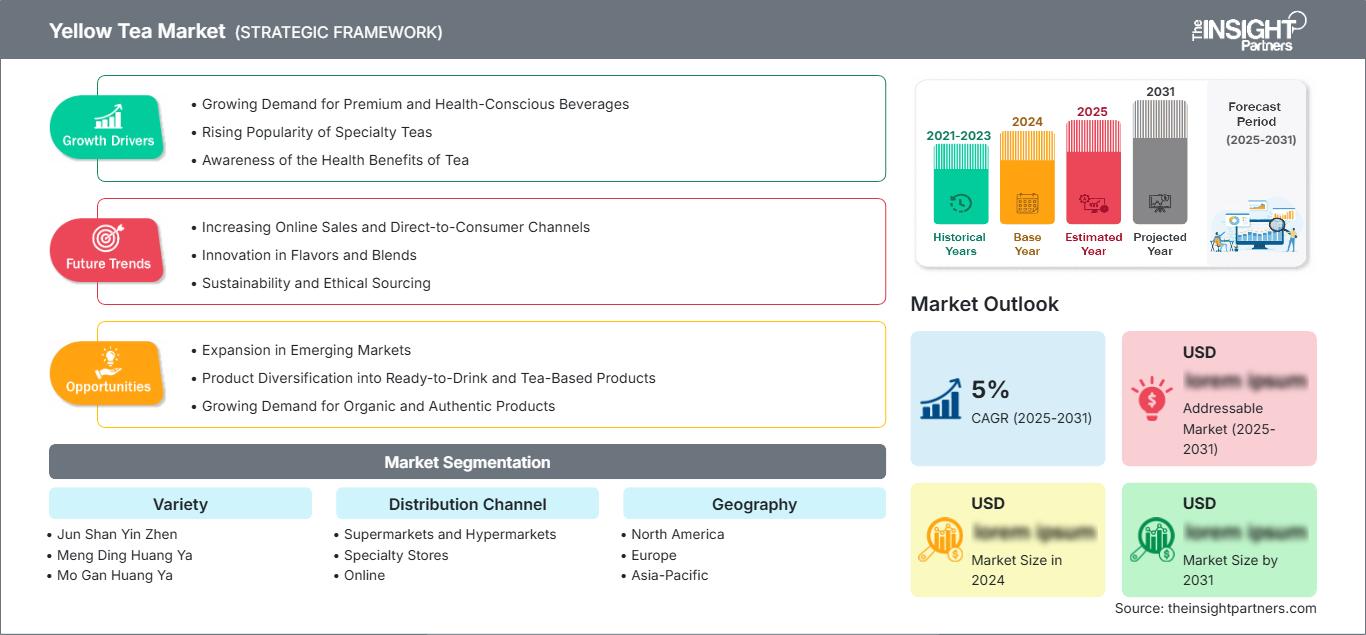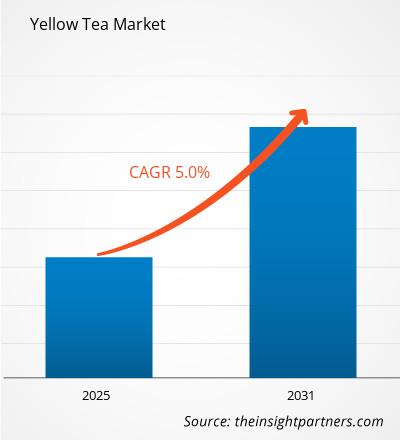Si prevede che il mercato del tè giallo registrerà un CAGR del 5% dal 2025 al 2031, con una dimensione del mercato in espansione da XX milioni di dollari nel 2024 a XX milioni di dollari entro il 2031.
Il mercato del tè giallo include l'analisi per varietà (Jun Shan Yin Zhen, Meng Ding Huang Ya, Mo Gan Huang Ya); canale di distribuzione (supermercati e ipermercati, negozi specializzati, online, altri) e area geografica (Nord America, Europa, Asia Pacifico, Medio Oriente e Africa, Sud e Centro America). Il tè giallo è una bevanda preparata dalla pianta Camellia sinensis e deve il suo nome al suo particolare colore giallo. Ha un sapore dolce e floreale. Il tè giallo è una bevanda stimolante che aumenta la prontezza mentale e allontana la stanchezza. Il consumo di tè giallo ha una serie di benefici per la salute segnalati.
Scopo del rapporto
Il rapporto "Yellow Tea Market" di The Insight Partners mira a descrivere il panorama attuale e la crescita futura, i principali fattori trainanti, le sfide e le opportunità. Ciò fornirà spunti a vari stakeholder aziendali, come:
- Fornitori/Produttori di tecnologia: per comprendere le dinamiche di mercato in evoluzione e conoscere le potenziali opportunità di crescita, consentendo loro di prendere decisioni strategiche informate.
- Investitori: per condurre un'analisi completa delle tendenze in merito al tasso di crescita del mercato, alle proiezioni finanziarie di mercato e alle opportunità esistenti lungo la catena del valore.
- Organismi di regolamentazione: per regolamentare le politiche e le attività di controllo sul mercato con l'obiettivo di ridurre al minimo gli abusi, preservare la fiducia degli investitori e sostenere l'integrità e la stabilità del mercato.
Varietà della segmentazione del mercato del tè giallo
- Jun Shan Yin Zhen
- Meng Ding Huang Ya
- Mo Gan Huang Ya
Canale di distribuzione
- Supermercati e ipermercati
- Negozi specializzati
- Online
- Altri
Potrai personalizzare gratuitamente qualsiasi rapporto, comprese parti di questo rapporto, o analisi a livello di paese, pacchetto dati Excel, oltre a usufruire di grandi offerte e sconti per start-up e università
Mercato del tè giallo: Approfondimenti strategici

-
Ottieni le principali tendenze chiave del mercato di questo rapporto.Questo campione GRATUITO includerà l'analisi dei dati, che vanno dalle tendenze di mercato alle stime e alle previsioni.
Fattori di crescita del mercato del tè giallo
- Crescente domanda di bevande premium e salutari: Grazie alla sua lavorazione unica, al suo sapore meno astringente e al suo sapore etereo, il tè giallo ha recentemente guadagnato la fama di essere uno dei prodotti di alta gamma sul mercato. I consumatori sempre più attenti alla salute richiedono bevande con i benefici aggiuntivi degli antiossidanti, che aiutano a controllare il peso e a rafforzare il sistema immunitario. Questi benefici aggiuntivi, oltre al gusto morbido e setoso del tè, hanno reso questo prodotto popolare tra i consumatori benestanti e attenti al benessere.
- Crescente popolarità dei tè speciali: I consumatori sono alla ricerca di tè speciali e, oltre al tè nero e verde, il tè giallo si adatta perfettamente come tè artigianale e speciale grazie alla sua rarità e al processo di produzione altamente sofisticato. I consumatori sono interessati a bere tè diversi e di alta qualità e la tendenza verso bevande artigianali e speciali sta stimolando la domanda di tè giallo in mercati come Nord America, Europa e Asia, dove la cultura del tè è in crescita.
- Consapevolezza dei benefici per la salute del tè: il tè giallo è ricco di polifenoli e catechine, che contengono proprietà antiossidanti, antinfiammatorie e antitumorali. Man mano che i consumatori conoscono i benefici per la salute attribuiti al consumo di tè, il potenziale del tè giallo sta diventando sempre più noto come fonte per migliorare la salute del cuore, favorire una buona digestione e, in generale, mantenere il benessere generale. Pertanto, il motore di crescita del mercato sono i benefici per la salute attribuiti al tè.
Tendenze future del mercato del tè giallo
- Aumento delle vendite online e dei canali diretti al consumatore: la tendenza verso l'e-commerce è più significativa nel mercato del tè speciale, incluso il tè giallo. Gli acquirenti acquistano sempre più tè pregiati come il tè giallo online e direttamente dai consumatori. La pandemia di COVID-19 ha ulteriormente accelerato questa tendenza, poiché gli acquirenti si sono rivolti alle piattaforme digitali per le loro esigenze di tè. I media online offrono accesso a prodotti di alta qualità e a informazioni preziose sull'origine, il sapore e i benefici per la salute del tè giallo.
- Innovazione negli aromi e nelle miscele: per attrarre un gruppo più ampio di consumatori e creare un'esperienza di acquisto migliore, la maggior parte delle aziende produttrici di tè sta attualmente sperimentando nuove innovazioni negli aromi. Tra queste, l'inclusione del tè giallo. Solo grazie a una domanda più elevata, esperienze di tè uniche e personalizzate potranno includere il tè giallo, grazie anche al crescente interesse per le miscele di frutta, erbe o spezie.
- Sostenibilità e approvvigionamento etico: la sostenibilità sta rapidamente emergendo come una questione fondamentale nel settore del tè. Prodotti ecocompatibili e di provenienza etica stanno conquistando il cuore dei consumatori. Con questa tendenza, i produttori di tè giallo si stanno concentrando su metodi di coltivazione sostenibili, certificazioni del commercio equo e solidale e imballaggi ecocompatibili. Questa tendenza riflette un più ampio movimento di consumo responsabile e ha influenzato notevolmente le scelte di acquisto, soprattutto quelle dei consumatori attenti all'ambiente.
Opportunità di mercato per il tè giallo
- Espansione nei mercati emergenti: se da secoli il tè giallo è ben posizionato in Cina e nelle aree asiatiche, opportunità molto più ampie si presentano nei mercati emergenti come India, Africa e America Latina. Poiché le bevande premium e salutari stanno diventando prodotti di punta in questi mercati, il tè giallo può stimolare la domanda, presentando ai consumatori locali il suo gusto unico e altri benefici per la salute. Questo sarà favorito da attività di formazione, campionamento e adozione per i mercati.
- Diversificazione dei prodotti in prodotti pronti da bere e a base di tè: l'aumento della domanda di prodotti pratici sta aprendo nuove opportunità all'ingresso del tè giallo nella categoria dei prodotti pronti da bere, ovvero le bevande a base di tè giallo in bottiglia. Il tè giallo può essere aggiunto a prodotti a base di tè sotto forma di bustine ed estratti, e anche a bevande funzionali come energy drink e beauty drink. Le innovazioni in queste linee possono consentire di offrire il tè giallo a un maggior numero di consumatori, e ciò rappresenterebbe una nuova fonte di reddito per i produttori.
- Crescente domanda di prodotti biologici e autentici: man mano che i consumatori diventano più esigenti in merito alla qualità e all'autenticità dei prodotti consumati, ci sarà una maggiore domanda di tè giallo biologico e di alta qualità. La certificazione biologica e l'approvvigionamento da piantagioni di tè tradizionali su piccola scala possono anche essere commercializzati verso una nicchia che valorizza l'autenticità e la purezza. Le aziende specializzate in tè gialli biologici e monorigine saranno nella posizione migliore per sfruttare questo crescente interesse dei consumatori.
Mercato del tè giallo
Le tendenze regionali e i fattori che influenzano il mercato del tè giallo durante il periodo di previsione sono stati ampiamente spiegati dagli analisti di The Insight Partners. Questa sezione analizza anche i segmenti e la geografia del mercato del tè giallo in Nord America, Europa, Asia-Pacifico, Medio Oriente e Africa, America meridionale e centrale.
Ambito del rapporto sul mercato del tè giallo
| Attributo del rapporto | Dettagli |
|---|---|
| Dimensioni del mercato in 2024 | US$ XX million |
| Dimensioni del mercato per 2031 | US$ XX Million |
| CAGR globale (2025 - 2031) | 5% |
| Dati storici | 2021-2023 |
| Periodo di previsione | 2025-2031 |
| Segmenti coperti |
By Varietà
|
| Regioni e paesi coperti |
Nord America
|
| Leader di mercato e profili aziendali chiave |
|
Densità degli operatori del mercato del tè giallo: comprendere il suo impatto sulle dinamiche aziendali
Il mercato del tè giallo è in rapida crescita, trainato dalla crescente domanda da parte dei consumatori finali, dovuta a fattori quali l'evoluzione delle preferenze dei consumatori, i progressi tecnologici e una maggiore consapevolezza dei benefici del prodotto. Con l'aumento della domanda, le aziende stanno ampliando la propria offerta, innovando per soddisfare le esigenze dei consumatori e sfruttando le tendenze emergenti, alimentando ulteriormente la crescita del mercato.

- Ottieni il Mercato del tè giallo Panoramica dei principali attori chiave
Punti di forza
- Copertura completa: il rapporto analizza in modo esaustivo prodotti, servizi, tipologie e utenti finali del mercato del tè giallo, offrendo una panoramica olistica.
- Analisi degli esperti: il rapporto è redatto sulla base della conoscenza approfondita di esperti e analisti del settore.
- Informazioni aggiornate: il rapporto garantisce la pertinenza aziendale grazie alla copertura di informazioni e dati recenti.
- Opzioni di personalizzazione: questo rapporto può essere personalizzato per soddisfare le esigenze specifiche del cliente e adattarsi in modo appropriato alle strategie aziendali.
Il rapporto di ricerca sul mercato del tè giallo può quindi aiutare a guidare il percorso di decodificazione e comprensione dello scenario del settore e delle prospettive di crescita. Sebbene possano esserci alcune valide preoccupazioni, i vantaggi complessivi di questo rapporto tendono a superare gli svantaggi.
- Analisi storica (2 anni), anno base, previsione (7 anni) con CAGR
- Analisi PEST e SWOT
- Valore/volume delle dimensioni del mercato - Globale, Regionale, Nazionale
- Industria e panorama competitivo
- Set di dati Excel
Report recenti
Rapporti correlati
Testimonianze
Motivo dell'acquisto
- Processo decisionale informato
- Comprensione delle dinamiche di mercato
- Analisi competitiva
- Analisi dei clienti
- Previsioni di mercato
- Mitigazione del rischio
- Pianificazione strategica
- Giustificazione degli investimenti
- Identificazione dei mercati emergenti
- Miglioramento delle strategie di marketing
- Aumento dell'efficienza operativa
- Allineamento alle tendenze normative






















 Ottieni un campione gratuito per - Mercato del tè giallo
Ottieni un campione gratuito per - Mercato del tè giallo